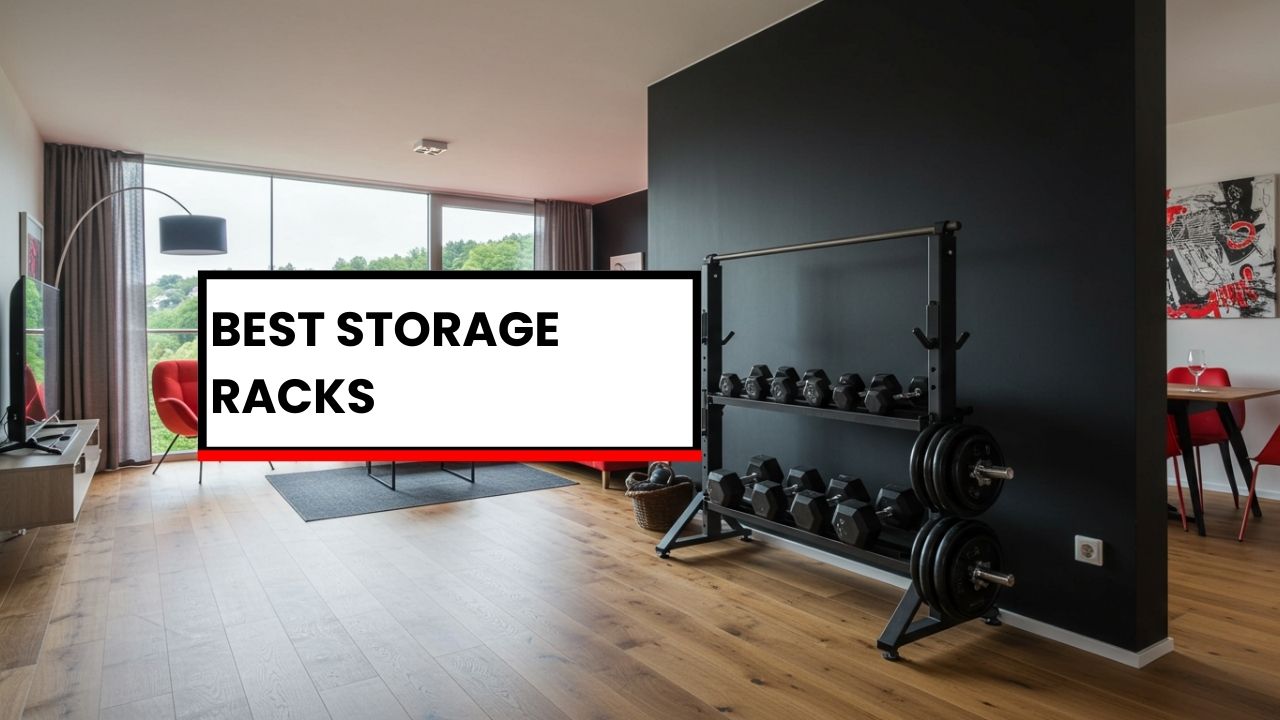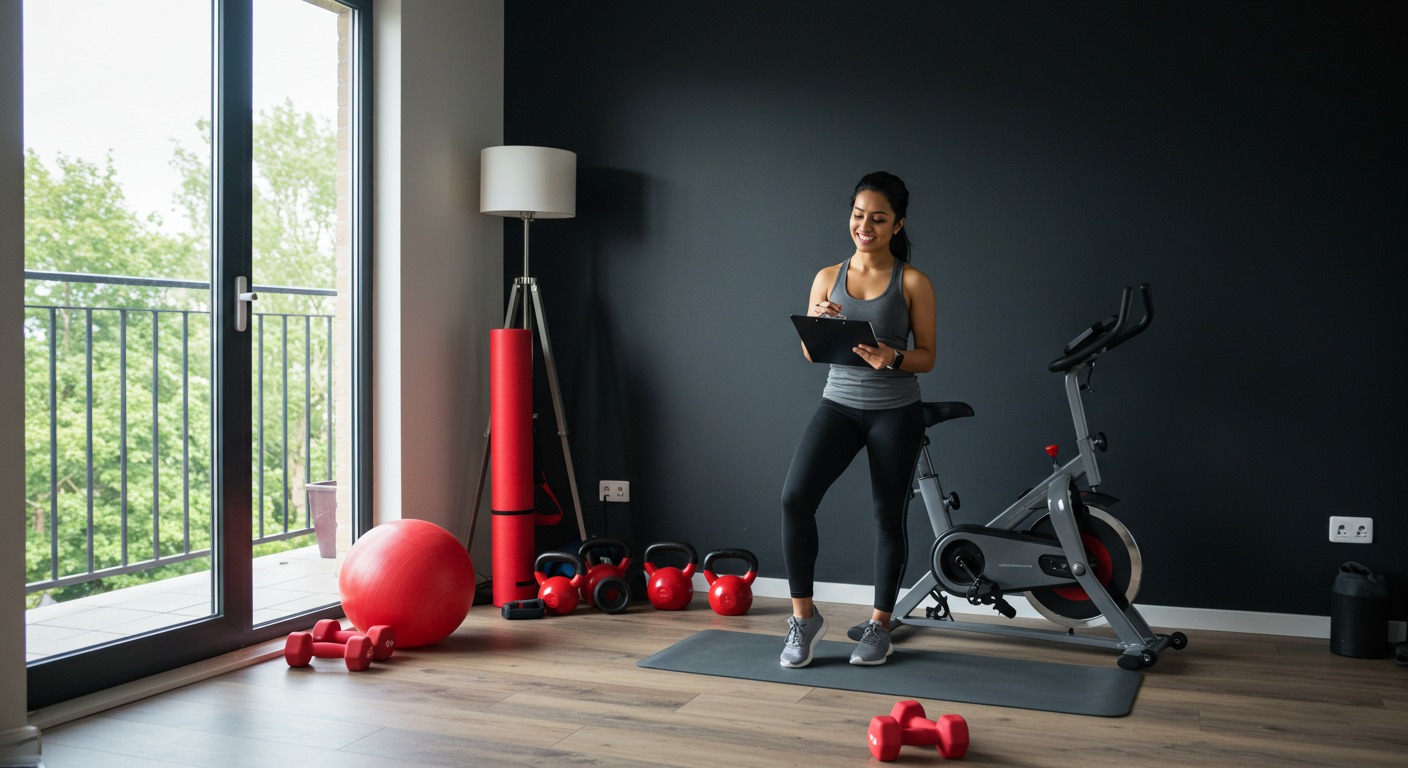Disclosure Information
This blog contains affiliate links. If you make a purchase through one of these links, our team may earn a commission at no extra cost to you. Learn more. Thanks for your support!
Organization is the unsung hero of an effective home gym. Even with top-quality equipment, a cluttered workout space can sabotage your motivation and training efficiency. Storage racks represent the solution that transforms chaotic gym corners into streamlined fitness sanctuaries.
For home fitness enthusiasts, proper storage isn’t merely about aesthetics. It directly impacts workout safety, equipment longevity, and the overall functionality of your training environment.
According to a recent home gym survey, 72% of respondents reported that improved organization increased their weekly workout frequency by at least two sessions (source: Home Fitness Journal, 2024).
This comprehensive guide explores everything you need to know about storage racks for your home gym – from the various types available to selection criteria and organization strategies that maximize your training space.
Benefits of Quality Storage Racks
Enhanced Safety
Proper equipment storage significantly reduces injury risks in home gyms. Weights, bars, and accessories left on floors create dangerous tripping hazards during intense workouts.
Designated storage keeps pathways clear and prevents accidents when moving between exercises. This becomes increasingly important as your equipment collection grows over time.
Maximum Space Efficiency
Most home gym enthusiasts work with limited square footage. Strategic storage solutions can effectively double your usable workout area by utilizing vertical space.
Instead of sacrificing floor space to equipment storage, vertical racks allow you to maintain an open training zone while keeping tools accessible. This vertical thinking transforms even modest areas into functional gyms.
Extended Equipment Lifespan
A study examining fitness equipment durability found that properly stored items lasted 35% longer than those frequently left on floors or stacked haphazardly (source: Equipment Maintenance Quarterly, 2023).
Quality racks prevent premature wear by eliminating improper stacking pressures. They also reduce cosmetic damage that occurs when items are dragged across floors or bumped into walls.
Improved Workout Efficiency
Organized equipment enables smoother transitions between exercises. When every item has a designated home, you eliminate time-wasting searches during workouts.
This efficiency becomes particularly valuable during timed workouts, circuit training, or HIIT sessions where maintaining momentum directly impacts results.
Types of Storage Racks
1. Weight Plate Trees and Holders
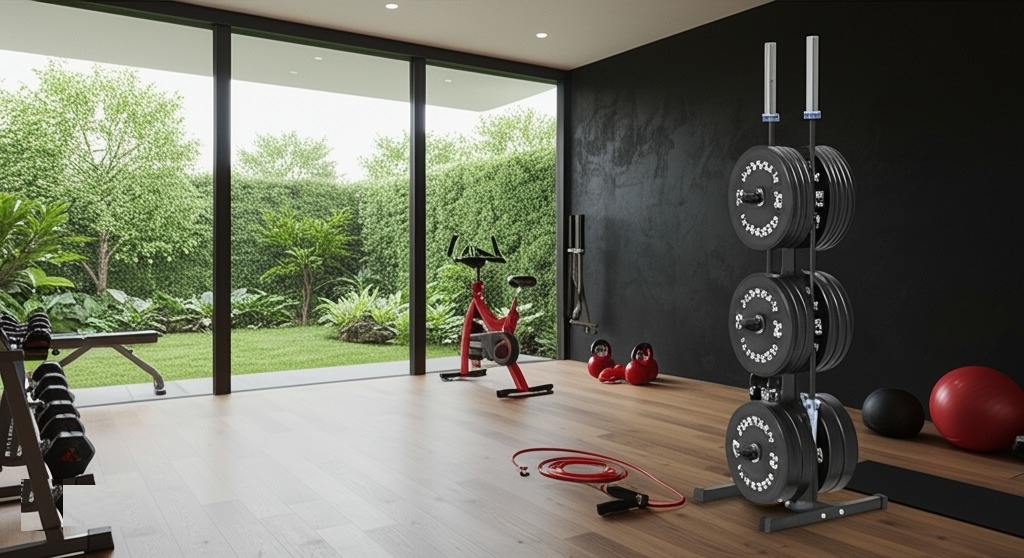
These vertical storage solutions keep weight plates organized, accessible, and off the floor. They represent essential storage for anyone with free weights.
Pros:
- Small footprint relative to the weight stored
- Enables organization by plate size
- Prevents plates from warping on floors
- Makes plate selection efficient during workouts
Top Recommendations:
| Model | Weight Capacity | Special Features |
| Titan Plate Tree | 500 lbs | Six weight pegs |
| Rogue Vertical Plate Tree | 800 lbs | Olympic and standard compatible |
| REP Weight Holder | 1000 lbs | Commercial-grade construction |
The Titan Plate Tree offers exceptional value for most home gym owners. Its combination of sturdy construction and reasonable pricing makes it the ideal starter option.
For those with extensive plate collections, the Rogue Vertical Plate Tree provides unmatched stability even when fully loaded. Its wide base prevents tipping during dynamic plate changes.
The REP Weight Holder stands out for serious lifters with heavy plates. Its reinforced frame and oversized weight horns accommodate bumper plates alongside traditional iron discs.
2. Dumbbell Racks
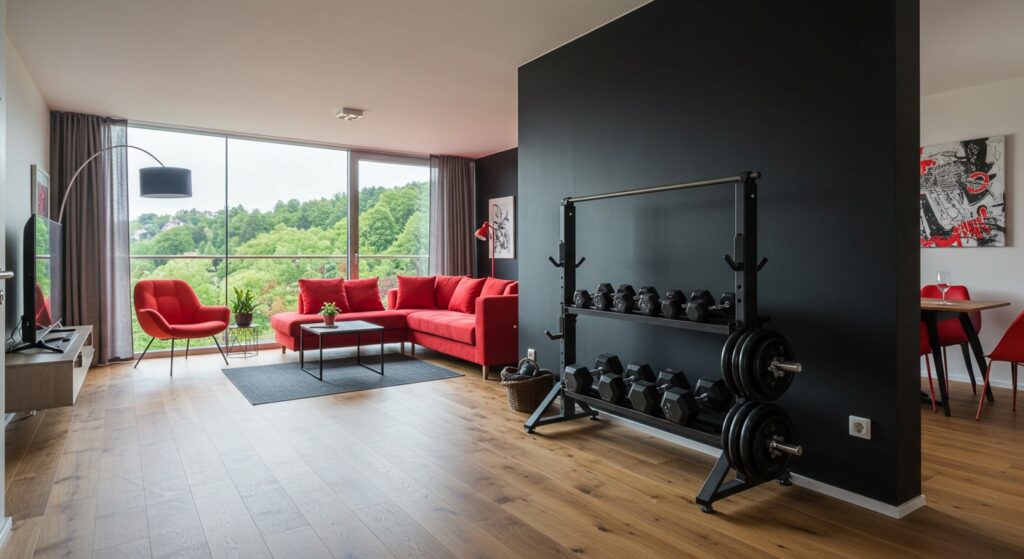
Dumbbell racks provide tiered storage specifically designed for hand weights. These range from simple two-tier designs to multi-level commercial-style options.
Pros:
- Prevents dumbbells from rolling
- Makes weight selection intuitive
- Protects floors from heavy dumbbell drops
- Often includes features for additional storage
Top Recommendations:
| Model | Capacity | Design Type |
| CAP 3-Tier Rack | 15 pairs | A-frame design |
| Marcy Multilevel Stand | 20 pairs | Vertical tower |
| Rogue Dumbbell Rack | 10 pairs | Horizontal tiers |
The CAP 3-Tier Rack delivers reliable performance for most home gyms. Its angled design makes weight identification and selection particularly convenient during workouts.
For comprehensive dumbbell collections, the Marcy Multilevel Stand offers superior capacity. Its vertical orientation minimizes floor space requirements despite the substantial storage capacity.
Those prioritizing build quality should consider the Rogue Dumbbell Rack. Though offering less capacity than alternatives, its commercial-grade construction ensures decades of reliable service.
3. Barbell Racks and Holders
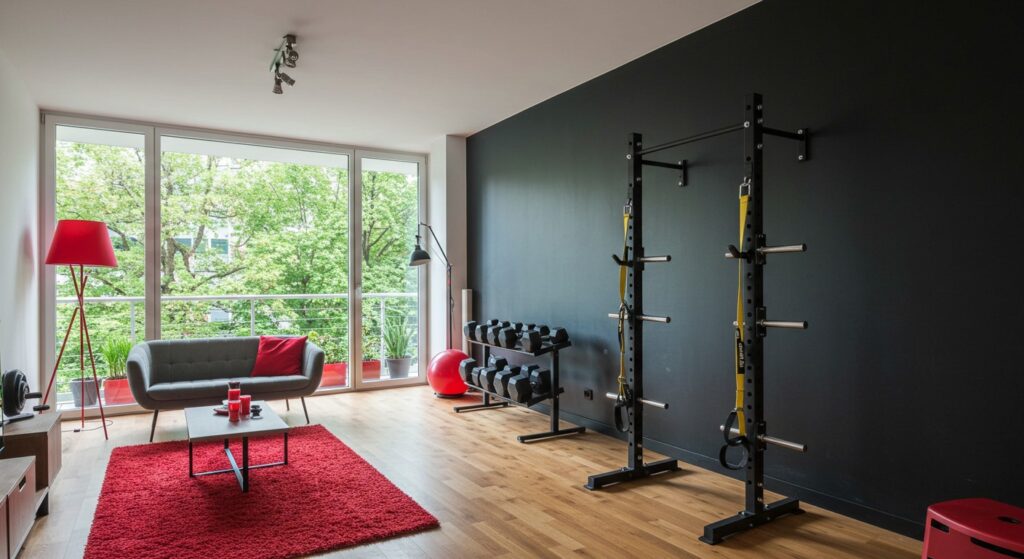
These specialized racks securely store Olympic bars, EZ curl bars, and specialty bars while keeping them easily accessible for workouts.
Pros:
- Prevents bars from warping
- Protects knurling from premature wear
- Minimizes floor space requirements
- Makes bar selection efficient
Top Recommendations:
| Model | Bar Capacity | Mounting Type |
| PRx Barbell Storage | 4 bars | Wall-mounted |
| Titan Gun Rack | 6 bars | Free-standing |
| CAP Vertical Holder | 3 bars | Corner design |
The PRx Barbell Storage system represents the ideal solution for space-conscious gyms. Its wall-mounted design completely eliminates floor footprint while keeping bars readily accessible.
For those with extensive bar collections, the Titan Gun Rack offers maximum capacity in a free-standing design. Its vertical orientation accommodates numerous bars in minimal space.
The CAP Vertical Holder utilizes often-wasted corner space effectively. This triangular design fits neatly into room corners while maintaining excellent stability.
4. Multi-Function Storage Systems
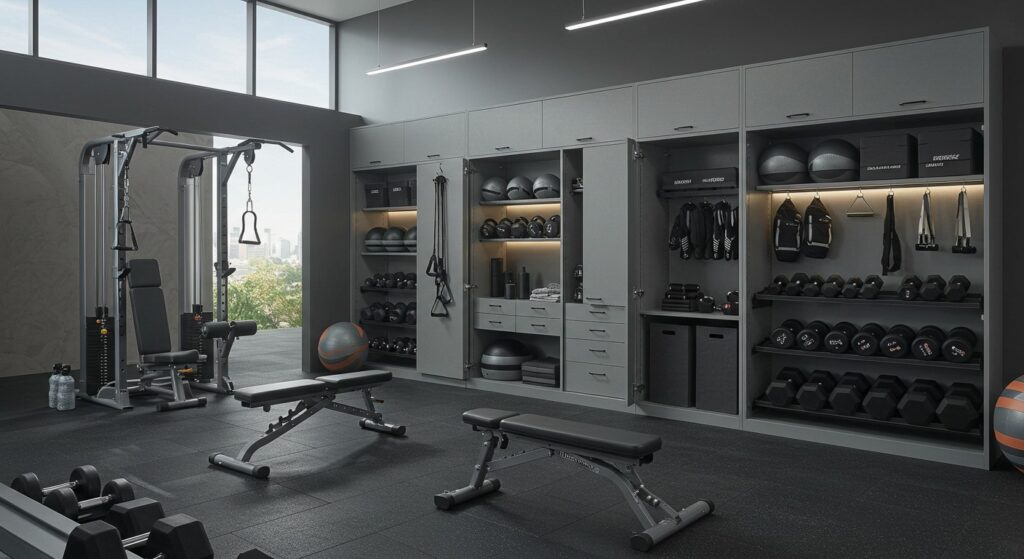
These comprehensive solutions combine storage for multiple equipment types within a single unit. They’re ideal for maximizing organization in limited spaces.
Pros:
- Single solution for diverse equipment
- Maximizes storage density
- Often more cost-effective than separate racks
- Creates cohesive gym appearance
Top Recommendations:
| Model | Storage Types | Footprint Size |
| REP Storage Tower | 5 categories | 4 square feet |
| Rogue Mass Storage | 4 categories | 6 square feet |
| Titan Wall Control | 6 categories | Wall-mounted |
The REP Storage Tower excels in versatility, accommodating everything from resistance bands to kettlebells within a remarkably compact footprint. Its modular shelving allows customization for specific equipment.
For heavy-duty requirements, the Rogue Mass Storage system handles substantial loads with ease. Though requiring more floor space, its robust construction supports even the heaviest home gym collections.
The Titan Wall Control system eliminates floor footprint entirely. This wall-mounted solution combines pegboards with specialized hooks to accommodate diverse equipment from minimal wall space.
5. Kettlebell Racks
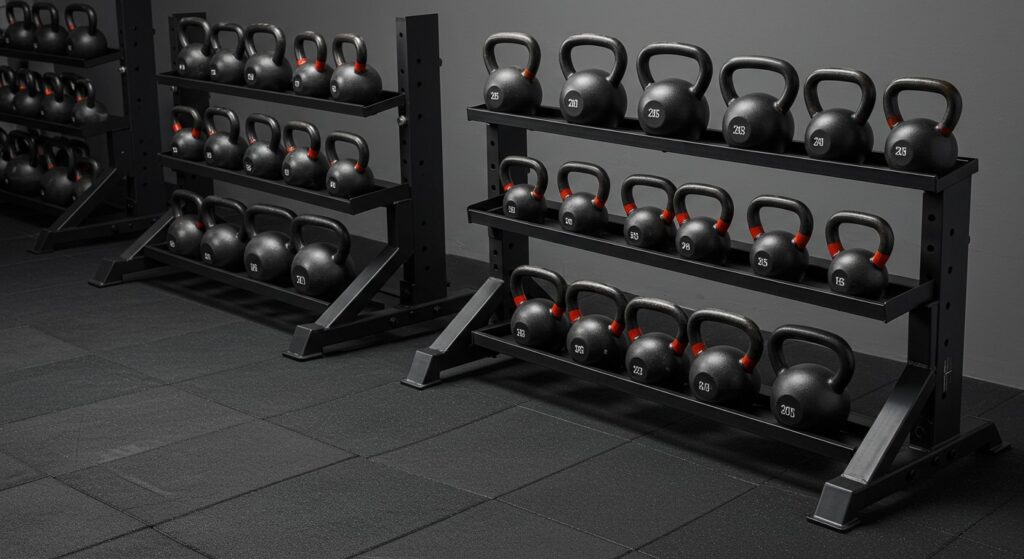
These purpose-built racks securely hold kettlebells at accessible heights, preventing the floor damage and clutter that loose kettlebells inevitably cause.
Pros:
- Prevents kettlebells from rolling
- Elevates heavy bells for easier pickup
- Organizes by weight for efficient selection
- Protects flooring from damage
Top Recommendations:
| Model | Bell Capacity | Design Features |
| REP Kettlebell Shelf | 10 kettlebells | Two-tier design |
| Rogue Kettlebell Rack | 6 kettlebells | Single-tier commercial |
| MDUSA Storage Rack | 8 kettlebells | Compact footprint |
The REP Kettlebell Shelf provides exceptional storage density through its multi-tier design. The staggered shelf heights accommodate bells of various sizes without wasting space.
For maximum durability, the Rogue Kettlebell Rack stands unmatched. Its overbuilt construction handles even the heaviest competition kettlebells without strain.
Those with space constraints should consider the MDUSA Storage Rack. Its vertical design maximizes storage capacity while minimizing floor requirements.
6. Accessory Wall Mounts
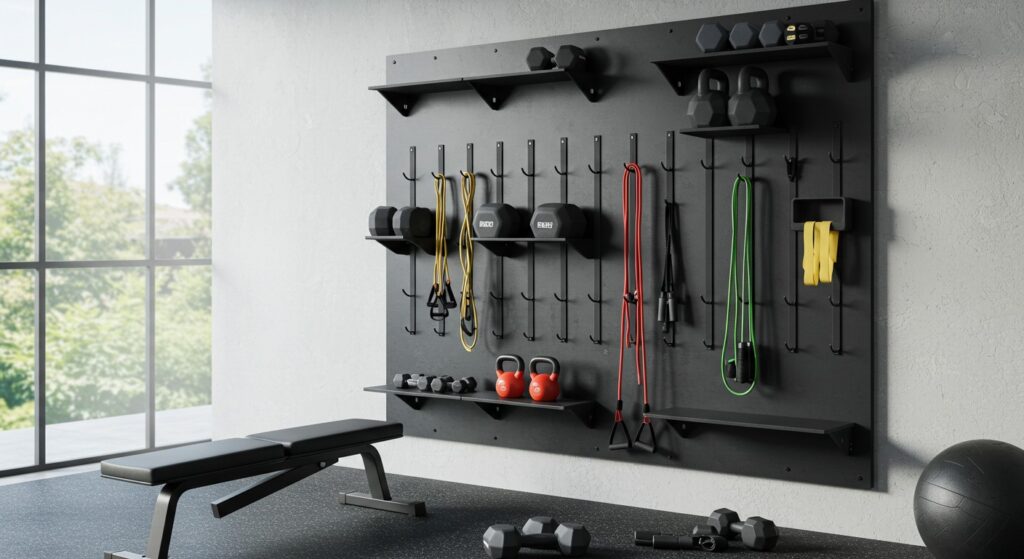
These adaptable systems mount directly to walls, transforming vertical surfaces into organized storage zones for smaller gym items.
Pros:
- Zero floor footprint
- Highly customizable configurations
- Makes accessories immediately visible
- Utilizes otherwise wasted wall space
Top Recommendations:
| Model | Organization System | Installation Difficulty |
| Rogue Strip Storage | Channel system | Easy |
| PRx Performance Panel | Grid system | Moderate |
| Harbor Freight Wall Control | Pegboard system | Easy |
The Rogue Strip Storage system offers exceptional flexibility through its modular design. The horizontal channels accept various attachment types that can be reconfigured as needed.
The PRx Performance Panel provides professional-grade durability with residential practicality. Its reinforced grid system handles substantial weight while maintaining a clean aesthetic.
Budget-conscious gym owners will appreciate the Harbor Freight Wall Control panels. Despite their affordable pricing, these steel pegboards deliver reliable performance for lighter accessories.
How to Choose the Right Storage Solution
Assess Your Equipment Collection
Begin by inventorying your current equipment. Note not just quantities but dimensions and weights to ensure compatibility with potential storage solutions.
Don’t neglect future planning. The most common storage mistake is underestimating equipment accumulation over time. Allow growth margin in your storage capacity.
Special attention should go to your most frequently used items. These deserve the most accessible storage positions to maintain workout efficiency.
Evaluate Available Space
Measure your available wall and floor space carefully. Remember to account for door swings, equipment movement areas, and safety clearances in your calculations.
Consider non-traditional spaces like overhead areas, corners, and spaces behind doors. Creative use of these often-overlooked zones can significantly expand storage capacity.
A 2024 analysis of home gym configurations found that wall-mounted storage systems increase usable exercise space by an average of 27% compared to floor-standing alternatives (source: Home Gym Architect, 2024).
Consider Construction Quality
Examine weight capacities carefully, especially for racks holding plates or multiple dumbbells. Quality racks typically specify weight limits clearly in product descriptions.
Assess material thickness and connection methods. Welded joints generally offer superior durability compared to bolted connections, particularly for heavy-use items.
Powder-coated steel represents the gold standard for most storage applications. This finish resists both corrosion and the inevitable scratches that occur in active gym environments.
Prioritize Accessibility
The best storage solution combines organization with accessibility. Equipment should require minimal effort to retrieve and replace during workouts.
Consider your workout style when evaluating rack designs. Circuit trainers and HIIT enthusiasts benefit from open, easily accessible storage that facilitates rapid transitions.
Those focusing on progressive strength training might prioritize secure, stable storage for heavy implements even if it requires slightly more effort to access.
Organization Strategies for Maximum Efficiency
Group by Function
Arrange equipment by workout purpose rather than strict equipment type. This approach keeps related items together, streamlining workout transitions.
For example, store deadlift accessories (straps, chalk, specific plates) together even though they represent different equipment categories. This functional grouping supports workflow efficiency.
Consider creating dedicated zones for specific movement patterns like pushing, pulling, and lower body exercises. This organization mirrors effective workout programming.
Prioritize by Usage Frequency
Place your most frequently used items at optimal heights – typically between waist and shoulder level. This positioning minimizes bending and reaching during busy sessions.
Reserve lower positions for heavier, less frequently used items. This approach reduces injury risk by limiting the need to lift substantial weights from awkward positions.
The top zones work best for lightweight accessories and rarely used specialty items. These higher positions keep occasional equipment accessible without sacrificing prime space.
Implement Visual Organization
Consider color coding or labeling systems for quick identification. This becomes increasingly valuable as your equipment collection grows more extensive.
Clear labeling proves particularly helpful for weight plates and dumbbells where weight identification streamlines selection during focused training sessions.
For multi-user gyms, visual organization systems help maintain order when different trainers have varying storage preferences and habits.
Create Dedicated Zones
Designate specific areas for cardio accessories, strength implements, and recovery tools. This zoning creates intuitive workflow throughout your training space.
Keep post-workout necessities (towels, cleaning supplies, water bottles) in a dedicated zone near your primary exercise area. This proximity encourages consistent cleanup habits.
For gyms with limited space, consider movable storage zones that can be repositioned based on the day’s training focus.
Installation and Setup Best Practices
Wall Mounting Considerations
Always locate wall studs when installing mounted storage. Drywall anchors alone cannot safely support substantial equipment weight over time.
Use appropriate hardware based on wall materials. Concrete, wood studs, and metal framing each require specific fasteners for secure attachment.
For maximum stability in wall-mounted systems, distribute weight across multiple studs rather than concentrating loads on single attachment points.
Floor Protection Strategies
Place protective mats under free-standing storage units, especially those holding substantial weight. This precaution prevents floor damage and improves stability.
For units placed on carpeting, consider solid platforms underneath to prevent uneven settling that could compromise rack stability over time.
In garage settings, moisture barriers between concrete floors and metal racks prevent corrosion issues caused by ground moisture migration.
Safety Checks
Regularly inspect all storage connections and weight-bearing elements. Even quality racks require occasional maintenance as fasteners naturally loosen with use.
Verify that all racks remain level and stable, particularly after adding substantial weight or moving equipment. Minor adjustments prevent progressive instability.
Ensure adequate clearance around storage solutions to prevent accidental contact during dynamic movements. This buffer zone prevents both equipment damage and personal injury.
Maintenance and Longevity
Regular Cleaning
Wipe down storage surfaces weekly to prevent dust and chalk buildup. This simple maintenance extends finish life while providing regular inspection opportunities.
Pay special attention to contact points where equipment meets storage surfaces. These high-friction areas typically show the earliest signs of wear.
For garage or basement installations, seasonal deep cleaning helps prevent moisture-related issues that can compromise both equipment and storage systems.
Preventative Care
Periodically tighten all fasteners and connection points. Even quality hardware naturally loosens under the vibration that occurs during regular gym use.
Apply light lubrication to moving parts like adjustable features and folding mechanisms. This maintenance prevents binding and premature wear of mechanical elements.
Consider protective coatings for high-wear areas, particularly on budget-friendly racks where finish quality may not match premium alternatives.
Conclusion
Investment in quality storage racks transforms your home gym from a chaotic collection of equipment into a streamlined training environment. Few additions impact daily workout quality as significantly as proper organization.
By selecting the right storage solutions for your specific equipment, space, and training style, you’ll create a gym that not only looks professional but functions efficiently for years to come.
Whether you choose specialized racks for each equipment type or opt for comprehensive storage systems, the organization these solutions provide will enhance safety, extend equipment life, and ultimately improve your training results.
FAQs About Home Gym Storage Racks
How much weight can typical storage racks support?
Weight capacities vary dramatically by design and construction quality. Budget models typically support 200-400 pounds, while premium options may safely hold 1,000+ pounds.
Should I prioritize wall-mounted or free-standing storage?
This depends primarily on your space constraints and whether you rent or own your home. Wall-mounted options maximize floor space but require permanent installation, while free-standing units offer flexibility but consume valuable floor area.
What’s the most cost-effective storage solution for beginners?
For those just starting their home gym journey, multi-function storage systems typically offer the best value by accommodating diverse equipment types within a single unit as your collection grows.
How do I prevent racks from scratching my equipment?
Quality racks include protective features like UHMW plastic liners or rubber coatings at contact points. For budget options lacking these features, applying inexpensive pipe insulation or furniture edge protectors provides similar protection.
Can storage racks be expanded as my equipment collection grows?
Many manufacturers offer modular systems specifically designed for expansion. When purchasing your initial rack, verify compatibility with expansion components to future-proof your investment.

